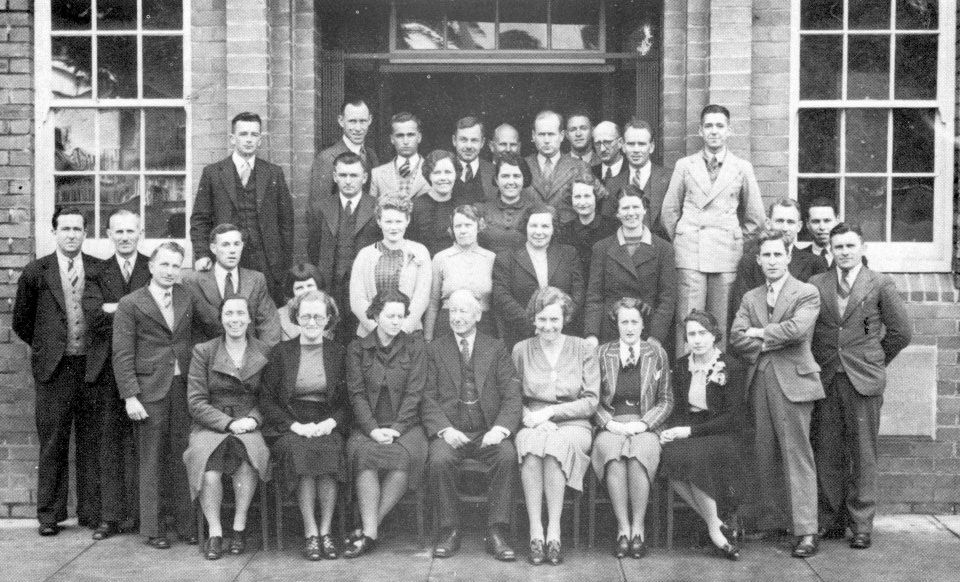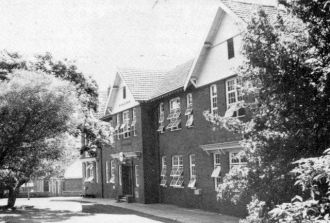Phyl Bennett – the War and Depression Years
That winter we prepared for war, two afternoons a week in bitter weather we waited at school until the country teachers rattled up in their little old cars (few had wages that allowed them to “splash” out in those days) and from four until five we applied ourselves to first aid, emergency drill (A.R.P. spelled Air Raid Precautions then) and the study of gases under Jim McBride’s tuition. Some did other courses with St. Johns or local doctors or ambulance officers as instructors. Was that the year the slit trenches were dug? It must have been,and I can still see Mr Pillans in his gown (the children called him Batman) waving us down into them, the one time we did take shelter in earnest. A red signal had been given and on a grey day with low cloud the sky was full of planes, audible but -invisible, with every pair of ears alert to recognise their “tune”. But the all clear came in time-for the afternoon trains home. The children had been checking that each train still ran!
For us here that was our nearest to the war itself and the trenches waited to be filled in again. Train watching however had become a compulsive process. Every morning bell brought in a reluctant crowd from the overhead bridge. Day after day loads or tanks (we knew each type including the infamous one-sided General Frants) went north and men as well – American mostly but often our own. In the evening the staff helped man a canteen in a shop opposite the railway.
I was there the night the first of the 9th came home to protect our north after their time in the Mediterranean. Never have I seen men so excited, so ecstatic about little things too. Threepences!” said one fingering his change as though they were talismans. – “Threepences:”. They were real silver and so small, with three heads of wheat on the reverse. Every child too, learned the silhouettes of all the planes, both those of our side and of the enemy and many too young yet to be called up spent hours plane spotting along the coast. And once the Command sent up a captured Japanese plane to test the posts! It was weeks before wild rumours died down. “I tell you I saw a Jap plane!” but they hadn’t read the follow-up explanation in the bulletins.
Local appeals concentrated on the war effort, so the school became self-supporting to supplement needs not met by the Department. Each term, one Friday was market day. Produce poured in from the farms and home gardens and out again as staff and town children made purchases. Cooks had been busy at home, and the school nursery had trees and plants potted. Each house competed to run stalls and side shows, competitions and revues. The young took over, uniforms cast aside, and crazy hats, bright clothes the order of the day. Adults were kept out, only the house patrons on the staff keeping a tight hand on the carnival. At its end, there was an auction of goods still unsold – an occasion of much mirth and a surprised teacher occasionally found he had purchased a plump kitten, a box of bantams or a bunch of carrots for which he had no recollection of making a bid.
The same system of children running these special days with no outside help was still in force when I left the school in 1959. It gave them confidence in themselves and great training in organisation. So did the prefect system. The names of captains are on the honour boards, but their deputies and the whole prefect force were admirable. Selected by vote of the senior school and the staff (who rarely upset the pupils’ choice) they set the tone and pace of school co-operation.
Two other social activities were well established; the frolics (Win Moore had settled on the name) held each term and the farewell dances to 5th Year, limited as the school grew, to fourth year hosting the departing classes. This was a formal occasion, held in whatever hall we could find (finally the Dwyer Pavilion) but in war time even it ended in time for the trains soon after eight. The frolics, of course, did likewise and where were most of them held? In the hospitable home of Mr & Mrs Mattocks, whose family of sons were all educated at the school but whose generosity* and cordiality made these joyous occasions within reach of every child, even from homes where pennies counted. Thanks indeed to them.
In the 40′s the strain grew. Rationing and labour controls tightened. Worst of all there was no-one able to see the end of the terrible conflict, nor to gauge the personal anxieties and losses among past pupils and the families of those we taught and of people we loved. The first fatality I remember was when a hospital ship was sunk off the Queensland coast and one whom I remember as a laughing bright spirit in Room 13 went to his death. Tobruk to me meant young Bruce Walpole living with the Rats, and the retreat from Greece (and a subsequent reconnaissance through the deserts of Syria) was Ted Walker-Smith, seeing the classic lands from odd angles. Changi held tall Mick Lovell, a mark for smaller men who broke his knee bones but not his spirit. He has visited Singapore since, with the tolerance that the men who really experienced war are the readiest to extend to their enemies.
Len Walpole, with his passion for boats, inevitably joined the Navy, and elsewhere we record the outstanding pilots who won awards for gallantry. Bill Pile, as well as his decorated brother, was in the Air Force and two of the Shipley boys, Harry and Don, ended up in prison camps after their planes came down, Harry’s in the craggy Appenines. These all returned, but Arthur Gossip was an only son, lost in the bombing of Berlin. Others can add to the list, people dear to them. I must add one more story of Elsie Kirk’s elder brother who spent years as a prisoner of war in rural Germany and wrote back through the Red Cross of the kindness of the family to whom he was sent as a farm labourer and whom he visited as a loved guest a year or so ago.
Meanwhile, after one last good joke with us, Mr Stoyles had retired. Our evacuation drill had got down to three minutes from siren to “All out, sir” from each block warden. “All. out, sir” said Allan Mclnnes, always gamesman of the staff. “Hum,” said Uncle Herbie, as the children call him affectionately. He looked under the back desk of room 8. “What about these two boys who fainted with shock, Mr. Mclnnes?” It was Mark Killingback and an offsider, carefully coached by the Headmaster to score a point off Allan.
For years Mr Stoyles who had a pleasant voice, delighted in local productions of Gilbert & Sullivan and had played lead in a comedy produced by the staff (opposite Mavis Chandler as “Jane”). He owned an extensive,library in his home with its fine garden of native plants and trees on the hill overlooking the road to Terrigal and there his wife and he welcomed and entertained his staff on many occasions. He was personally interested in his pupils especially when the school was small and closely bound up with the life of the town and loved the art of the teacher. Who else would have sat in on a fifth year class on “Lear” each Friday for three months, arriving one morning five minutes late and exclaiming in an indignant mumble, “I was kept late by a silly call from the Department”.
When the war came, he spent his time, as a discipline almost, making camouflage nets, because he felt he could not return to teaching as a “retread”. He also undertook the indexing of the Australian Historical Society’s Journals, as another great interest was our own development as a nation. Mention must be made of his wife, prominent in the Country Women’s Association and in every other worthy activity, a lovely lady.
It is pleasant to remember that at least three outstanding scholastic achievements by pupils came in these early years. Eleanor Arnott, repeating her Leaving Certificate as she was very young when she first passed, came first in the state in Chemistry, Bruce Holcombe, after gaining a full 8 A’s in the Intermediate, achieved a full pass at his second Leaving Certificate (ie. 3 honours and the rest A’s) and Cyril Renwick, third in the state in English in 1937, was first the following year. Medicine, Law and a distinguished academic life followed for these brilliant students.
In 1941 and 1942 Mr Pillans was Headmaster but it was the personality of Cog Thomas, who had been Mr Stoyles’ deputy from 1939, that most of us remember as the quiet force that influenced the school for the four years until Mr Lake became deputy. The war had depleted the male staff by then, and the Maths staff, apart from Mr Thomas himself, finally consisted entirely of women. Needless to say, they became known as The Harem. These were the people on whom fell the responsibility of training the lads who were to become the young trainee pilots, mechanics, naval cadets, at a time when efficiency was essential, a fact often forgotten when the men returned after the war and women had to struggle to gain promotion. There were rights on both sides but disappointment followed-overwork for many women who stayed put during those years of strain.
A further strain was the depressing appearance of the school during that period, windows taped over with strips of calico (we had stuck it all on ourselves) to prevent glass shattering in air-raids, the interior of the school growing dingier and dingier. The exterior had been painted to preserve the woodwork, but the crew were withdrawn for “more urgent duties” just as they had scratched down the inside walls and replastered the cracks. No painting to cover the scars. We looked at those hideous blotches until Mr Barwick took definite action in 1955, and at last the lower corridor, at least, looked welcoming. How I envy the present covered floors and light walls.
FROLICS:
“Frolics” are equivalent to a formal dance of today. They included such dances as the Barn Dance, Canadian Three Step and Pride of Erin. All pupils were invited to attend this annual event which was the highlight of the school year. These frolics were usually conducted in the Gosford or Masonic Hall, and later in the Dwyer Pavillion, beginning at 4 p.m. and ending after much excitement at 7.45 p.m. As many pupils had to travel great distances to school, coming from as far as Awaba and Spencer, the boys would often wear their frolic clothes to school. The girls brought their formal dance dresses with them and the occupants of nearby houses were kind enough to let the girls prepare for the party there. Most frolics were run by a committee of 4th formers who provided the students with a supper which usually consisted of cordial and sandwiches


